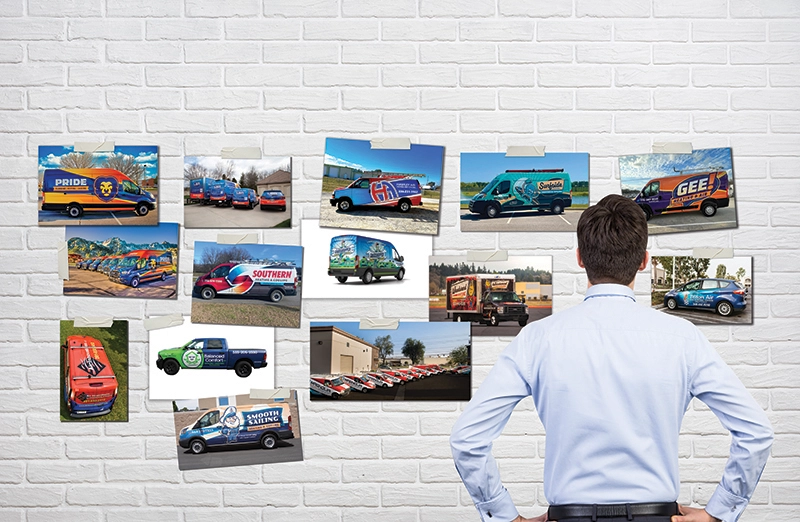When my father founded Frymire Services Inc. in 1950, he had a marketer’s eye for color. But he also was a manly Texan, so when it came time to choose a color scheme that would stand out, he passed up pink for a yellow-and-black combination. Over the past 61 years, our customers and our community have come to associate these colors with our company and our bestin- class service — so much so that we now have a competitor with the same colors.
In overseeing the most recent redesign of our fleet of 90 vehicles, I knew that my No. 1 responsibility as company leader was to preserve those colors and other design elements that have clearly become part of our brand. At the same time, I recognized that our trucks themselves are an extremely important component of marketing, and so the new design needed to be modern while still conveying Frymire’s culture of traditional business values.
In short, the process was important enough to deserve as much of my time and attention as needed.
Your company might not have the same history or culture as Frymire, but your fleet design is just as important. Think of your vehicles as billboards on wheels. They say a lot about your company. Shouldn’t you be leading the process that decides what they will say and how they will say it?
If you decide to take up this challenge, consider these “lessons learned” from my experience:
Use design professionals: You might think you know what looks good, but you are not a design expert, and probably, no one on your payroll is either. When we started our process, the first company we called was a company that has always provided outstanding fleet graphic services to us. They are a great provider, but in the very first conversation, I got the feeling that we weren’t going to get the creativity that we wanted. We called the advertising company that designs our billboards because the same principles in billboard design apply to fleet design. They and the fleet graphics provider were more than happy to work together to assist us in redesigning our fleet. This team of expert design professionals were instrumental in creating our effective and award-winning design.
Give designers a working document and template: Even though you are not a design professional, you are a company leader, and therefore should know what your company stands for and what is most important to convey to customers through the design. Codify this knowledge as specifically as possible in an organized, written document that the designers can begin working from. It is even acceptable — and in many cases appreciated — to provide a template of lettering or a design if you have specifics in mind. For this, we downloaded vehicle templates (readily available from several stock-photo Web sites) to create an overlay for the initial lettering and scale we envisioned. It was easy to do and gave the designers a creative running start.
Think ahead about how else the design will be used: When preparing the design document, be sure to consider how the design will be used in other marketing materials. Will there be a picture of a company van on your Web site? If so, the “message” of the design needs to come through in a digital environment (smaller size, lower resolution, etc). Will a photo of a truck be on a billboard or other large illustration? If so, the design must work at a larger size.
Keep highly recognized elements: We did not involve our technicians in the design process. Their skills are best used in the field serving customers. One thing your techs and salespeople can tell you, though, is what people remember about your existing fleet design. If you’ve been in business a long time, you probably already know this from comments you’ve heard yourself. If not, ask your staff and even loyal customers. Once you have identified these elements, explain in the design document that you want them to remain.
Go for contrast: No doubt about it, contrasting colors get attention. If someone is suggesting that you use one color or one color palette in your design, ask for another opinion. People aren’t going to be looking for your trucks, and when they do see them, they aren’t going to stare at them. Before a design says anything to a potential customer, it has to get the attention of the potential customer. Contrast will do that.
More is less: This point is mostly opinion, but it has worked very well for Frymire. We go on the principle that whatever someone can’t absorb in three seconds is a distraction. Include the information that is most important to convey, and add sparingly from there.
Have multiple test viewings: Do your vehicles disappear when the sun goes down? Do they all travel at the same speed and the same distance from other vehicles and pedestrians? Of course not. View your proposed designs in the daylight and nighttime, and at a variety of distances and speeds. After doing this, you might decide to add type that reflects light in the dark, or to add your phone number to the back of a van. These tweaks will go a long way toward making your design as effective as it can be.
Over the years I’ve learned that people in our community might not know every single service we provide, but they know our trucks when they see them. This tells me that the Frymire fleet is more than a collection of vehicles. It is who we are. That’s why I do more than “find time” when it comes to how our fleet looks and what it says. I make it a priority.
George “Read” Frymire is president of Frymire Services Inc., the company his father founded in Dallas in 1950. Frymire, which provides both residential and commercial services, won the 2009 Tops in Trucks Award in Lettering. Here, Read Frymire gives seven tips on leading the redesign process.



